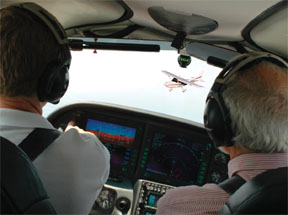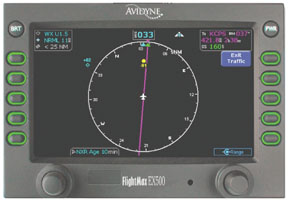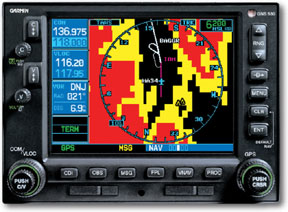
by Larry Anglisano
Whether its a fair assessment or not, high on the list of things owners worry about is a mid-air collision, despite the fact that mid-airs account for a barely measurable percentage of accidents. When upgrading the panel, everyone seems to shop the panel-mount traffic avoidance device market but not everyone buys. The reason is simple. These systems remain expensive and when confronted with a $25,000 install invoice, many owners decide they can do without.
Nonetheless, if see-and-avoid doesnt fill you with confidence, a panel-mount traffic nag may continue to rise to the top of your must-have list, something we understand. Frankly, when we fly aircraft not equipped with traffic alerting equipment, were uneasy. In this report, we’ll scan the most popular current market offerings in panel-mount traffic gear and explain our mixed feelings when flying with any of them.
Trickle Down
The more expensive of the traffic alerting systems for light aircraft follow the lead of technology put into place in the late 1980s and appropriately called traffic alert and collision avoidance system or TCAS. TCAS systems, through interrogation of nearby transponders, display an industry-standard array of symbols and colors along with aural warnings to warn of conflicting traffic and its position in relation to the host airplane.
Later TCAS II technology took this one step further and offered so-called resolution advisories in the form of commanded climbs or descents. TCAS II is largely airline gear and beyond the budget and needs of light aircraft owners. The FAA and the avionics industry refers to non-TCAS conforming (read lower end) systems as TAS systems or traffic advisory systems.
Systems that use the interrogation method, as TCAS does, are called active systems while anything else is considered passive, merely listening for pulses from other transponders interrogated by ground-based secondary radar.As we reported in the August 2005 issue, a third variant is proposed and slowly coming on line: the automatic dependent surveillance system that will eventually replace radar with GPS-based automatic position reporting. ADS-B also includes a cockpit traffic display, but its so far from deployment that we don’t consider it a practical purchase solution right now. we’ll look at it again in six months or a year.
Bendix/King KTA870
With roots planted deeply in traffic gear technology, Honeywell/Bendix/King could be considered a grandfather of TCAS technology. The KTA870 TAS system is a descendent of the popular big-airplane TCAS systems which were well-proven by Honeywell and copied by others years ago.
The KTA870 is an active system, using dual KA815 directional antennas, one mounted on top of the aircraft, the other on the bottom. The processor, an 8.75-pound remote box, feeds a variety of Honeywell/Bendix/King displays including the KMD850/550/250 displays that are part of the IHAS (Integrated Hazard Awareness System) as we’ll as the KI828 EHSI and higher-end EFIS.
Tracking up to 60 targets and displaying the 30 most threatening, the KTA870 has an operating surveillance range between 2 and 40 miles while identifying three threat levels. Non-threat aircraft-within plus or minus 1200 feet or at a range greater than 5 miles-are displayed as a hollow diamond with the appropriate relative altitude tag and a trend arrow. A solid diamond represents intruding aircraft that are at an altitude and range closer than 1200 feet and 5 miles.
When the processor determines that the closure rate of the painted traffic is 30 seconds away from a real conflict, it issues a traffic advisory warning that triggers a solid yellow circle and audible traffic alert. Thirty seconds is the processed milestone event, which Honeywell calls the closest point of approach. The system will display other aircraft plus or minus 8700 feet in the vertical from its own target.
The system can be configured for different phases of flight, such as above mode for departure-targets at 8700 feet above and 2700 feet below-protecting from conflict during a climb. Once in cruise, you can switch the system to terminal mode, where it will display targets 2700 feet above and below. For the descent and landing, below mode concentrates on targets 8700 feet below and 2700 feet above. These ranges are well-suited to protect even the quickest of light airplanes going uphill, downhill and in level cruise.
The KMH880 system bundles the KTA870 and the KGP560 EGPWS processors in one box, which Honeywell labels the Multi-Hazard Awareness system. So its an all-in-one-shot upgrade for a turbine airplane that needs to comply with the TAWS mandate, but which also needs a TAS system. The KTA870 systems we have used on a variety of displays are intuitive and easy to manipulate and have rock-solid performance.
With either of these systems, the need to install two antennas is a nuisance and while it increases the labor costs, the concept is that there will be less shadowing of potential threats. There’s a single bottom antenna option for the Honeywell system, aimed at aircraft with fixed landing gear.But we think that better performance will be obtained through dual antennas, despite the cost. As shown in the chart on page 5, this is a very expensive system, beyond the reach of the typical piston aircraft owner.
Ryan TCAD
Columbus, Ohio-based Ryan International-its founder Paul Ryan, invented the first spherics system-is a veteran in what they call the traffic collision alerting device or TCAD. The companys first product was a passive transponder detector but recently, Ryan has branched into active technology with the flagship 9900BX. It stands alone in the market providing audible position alerting (APA) for conflicting traffic.
For example, as an approaching threat nears, the system issues an audible traffic alert followed by the threats direction, vertical position and its distance. When we flew with the 9900BX in a Baron, we were startled when the system interrupted our descent checklist, calling traffic at our 3 oclock, low, 1 mile. Sure enough, as we swiveled our heads and dropped a wing to the lower right, a Bell 407 helicopter was less than a mile away.
The published tracking range of the 9900BX is 20 miles, tracking 50 targets and capable of displaying up to nine, using an ARINC interface.Targets can be presented on the standard ATI digital display or on a variety of MFDs, including those from Avidyne, Garmin, Honeywell, Chelton, Sandel, Eventide, Collins and Universal. Ryan clearly has the display market covered with its many interfaces.
We think that the standard ATI display is dated and not nearly as useful as playing the traffic on a large MFD, overlaid on your flight plan. On the other hand, this tech nology was developed before MFDs became common and most airplanes that qualify for the $22,390 9900BX will already have an MFD, eliminating the need for the dedicated Ryan TCAD display.
A new product from Ryan, called the Color Multi-Hazard D isplay (MHD) is a specialty 3-inch ATI, high-resolution display and while still under pending TSO approval, it can show TCAD traffic (from the 9900BX processor), terrain data (from the Honeywell KGP560 and numerous other Honeywell terrain systems) and even lightning data from the WX-500 Stormscope. It can show a traffic target with N-number ID as we’ll as the targets transponder squawk. we’ll cover this display as we’ll as others like it in a future report.
Other standout features of the 9900BX include an integral altitude alerter that annunciates altitude to go to the entered target altitude. If you blow through the selected altitude by 200 feet, the system reminds you to check altitude. Youll be rewarded with an at-altitude callout if you arrive and stay at the entered altitude.
The lower cost ($9280) Ryan 9900B system is a passive system that also uses dual antennas, but its range is limited to 6 indicated nautical miles and the display of only three threatening targets. It doesnt feature audible position callouts and it wont interface with the multi-hazard display, although this is planned for the future, according to Ryan.

An existing 9900B system can be upgraded to the active 9900BX using the existing antennas and much of the interface wiring. As we go to press, Ryan has teamed with Avidyne and is offering a sizeable discount for bundling a 9900BX and EX500 MFD, sweetening the deal for both systems, which we consider excellent performers.
L-3 Skywatch
Enjoying a solid and reliable record in service, the active Skywatch products from L-3 remain popular options and standard equipment on many light airplanes, including new Cirrus airplanes. A descendant of earlier TCAS systems designed by BF Goodrich, the L-3 Avionics Systems Skywatch and Skywatch HP are targeted at and are commonly found in light high-performance pistons through light jets.
The Skywatch uses a single directional NY-164 L-Band antenna (11 x 6.25 x 1.40 inches, weighing 2.3 pounds) mounted on the top of the aircraft, although select installations, mostly on rotorcraft, allow installation on the belly. Through the directional antenna, the Sky497 processor-a 9-pound remote box-computes the threat aircraft bearing, range, relative altitude and rate of closure and warns of potential threats within 11 miles.
Up to 30 intruder aircraft are simultaneously tracked and eight of the most threatening are displayed using TCAS-like symbology on a wide variety of displays including a dedicated CRT monochrome Skywatch display, the WX1000+ Stormscope CRT monochrome display, the Garmin GNS500/400 series, Garmin MX20 and iLinc MFDs, Avidyne 500/5000 series MFDs, Collins Pro-Line and Universal displays found in big airplanes, plus interfaces with Honeywell IHAS displays, all via RS232 interface.
Through the L-3 RGC350 graphics interface computer, Skywatch traffic can be displayed on some ship radar indicators, too. Audible traffic alerts can be played through most audio systems. Just like the Honeywell system, the Skywatch has multiple vertical display modes and familiar TCAS-like symbology for traffic representation. For example, BLW is a-below-the-aircraft mode that displays traffic 9000 feet below and 2700 feet above, ABV is for targets 9000 feet above and 2700 feet below while NRM is a normal cruise mode displaying targets 2700 feet above and below the aircraft.
The more powerful Skywatch HP is aimed at speedier airplanes, displaying traffic in +/- 100 foot resolution with surveillance ranges of 2, 6 and up to 35 miles, plus an unrestricted surveillance vertical mode, all with an effective closure rate of up to 1200 knots. Further, with an appropriate display and when interfaced with the NY-156 antenna, the Skywatch HP can be interfaced to comply with TCAS 1 certification criteria, making it a player for some air carrier applications at a reasonable cost, compared with traditional TCAS systems.
For retrofit, the Skywatch systems from L-3 are often overlooked, especially when owners consider the MX20 Traffic MFD. L-3 often offers substantial savings when purchasing a Skywatch/iLinc combination, as we’ll as bundling one with the Landmark TAWS systems.
We caution against trying to interface newer MFDs such as the MX20 with older Skywatch systems without ensuring that the Skywatch processor has the latest software and hardware mods. Bugs have proven to be an annoying and costly affair in such installations. But when the software and hardware play in harmony, Skywatch is a rugged, reliable and proven active-TAS system, in our view. The single antenna, although large in size, might require less labor time than other systems.
TIS Datalink
We covered ADS-B (Automatic Dependent Surveillance- Broadcast) technology in the August 2005 issue of Aviation Consumer and, as noted, the $7995 Garmin GDL90 remains the only ADS-B equipment available for retrofit. But ADS-B isn’t a player yet because the FAA hasnt built out the ground stations.Maybe when the agency gets off the dime, the cost of ADS-B will decline. But for now, we consider it a non-starter.
That leaves the Mode-S based traffic information system or TIS datalink that relies solely on secondary surveillance radar transmitting through a Mode-S transponder, of which there are two: The Garmin GTX330 and the Bendix/King KT73. The relative location and trend of movement of Mode-A, Mode-C and Mode-S equipped airplanes within a specified service volume of terminal radars is what TIS paints, so aircraft with inoperative or transponders switched to off wont be visible to a TIS host system. TIS data is generated approximately every other sweep of the radar, or every 4.7 seconds, thus traffic data is about five seconds old before it reaches the host aircraft.
TIS can display up to eight traffic targets within 7 nautical miles in the horizontal from 3500 feet above and 3500 feet below the host aircraft, at a range of approximately 50 miles from the TIS radar. Using predictive algorithms, the ATC ground tracking software uses track history to present near real-time traffic data to the host aircrafts TIS transponder, which then displays the traffic on a screen using TCAS-like symbology.
As regular TIS users, we can say the system has several disadvantages compared to other systems, either active or passive. If a threat aircraft is maneuvering quickly, the TIS-transmitted data could be somewhat inaccurate, not unlike receiving the same traffic report from a controller verbally communicating what he is seeing from his radar screen. Second, TIS doesnt work when youre out of range of the terminal radars where its installed.Third, as we reported in August, the FAA is slowly discontinuing TIS at some low-density terminals.
However, even with these shortcomings considered, the cost of equipping an aircraft with TIS traffic is lower than any other panel-mounted TAS system, thus TIS datalink transponder technology has been a huge success to date. See the sidebar for more information on the future of TIS.
Based on our discussions with Bendix/King and Garmin, Mode-S transponders with TIS datalink capabilities might be useable in the ADS-B traffic world and the KT73 Mode-S transponder with TIS is advertised as one such unit which will play in both worlds through field software updates.
The KT73 is a solid-state, digital design that picks up where the earlier model KT70 Mode-S transponder left off, receiving the TIS uplink for traffic display on the KMD250/550/850 and KI825 EHSI displays. It has a list price of $5220, not including the displays mentioned.
Garmins popular GTX330 Mode-S TIS transponder ($4995) displays on the GNS500/400 series systems as we’ll as the MX20, iLinc and the Avidyne EX500 MFD when equipped with software version 2.0.
And much to our awe for sneaking it by the FAA, the GTX330 is compatible with the new portable GPSmap396, via a cable and jack arrangement. Like the KT73, the GTX330 outputs standard TCAS-like symbology (with relative direction of movement and relative altitude) for traffic representation as we’ll as audible alerts for conflicting traffic and an audible basic altitude buffer feature.
A remote version of the Garmin GTX330, the GTX33, will play on the GNS480 and Garmin G1000 displays, where all transponder functions are controlled via screen menus. Based on the average buy-in of about $6000 for a Mode-S TIS transponder (plus a display) and the number of owners who have already invested in the technology, it would be a shame for the FAA to abandon it, with or without ADS-B developing downstream.
Conclusion
After much flying with a variety of TAS and TIS systems (as we’ll as full-blown TCAS systems), we view the technology as a double-edged sword. First, were becoming increasingly paranoid about running into other aircraft because of the number of painted targets that we never acquire visually or that ATC never notices or announces. Frankly, its creepy.
On the other hand, on-screen traffic will make you crazy with distraction, if you let it. When cockpit workload is high, we sometimes wish the thing would just go away. At least for a few minutes. Call it the yin and yang of high-tech.

What to do here if you want panel-mount traffic gear? If you have a fat budget and a high level of paranoia, our first choice is the L-3 Skywatch.Goodrich put a ton of money into developing TCAS and Skywatch reaps the benefits. Furthermore, because its an active system, it works almost everywhere and it plays on the largest choice of displays. Downside: The $24,000 price tag if you don’t have a display, $18,525 if you do.
The alternative is the Ryan 9900BX, a credible system, but one that lacks the TCAS heritage and costs more. Its hard to make an argument that its a better system. In our view, that leaves one high-value choice: TIS-based traffic alerting from either Garmin or Bendix/King. This system works we’ll where it works and that includes most congested terminal areas where you want it most. If you have a suitable display, the cost is one quarter or less than that of a full-blown active system, which strikes us a good value.
But TIS doesnt work we’ll at low altitudes and when youre out of a terminal radar service area, it doesnt work at all. So the question every buyer must confront is this one: Is it worth an additional $15,000 or more to have an all-seeing, all-knowing active system? Our view is no, the cost-value ratio is not attractive. You may feel differently if youve nearly swapped paint with another airplane recently. In that case, pay a premium for an active system or consider one of the portable options.
Also With This Article
“Checklist”
“Product Descriptions And Comments”
“Why TIS Is Still A Good Bet”
“Portable Options: Azimuth Arrives”
Contacts
Bendix/King, 877-712-2386, www3.bendixking.com
L-3 Communications, 616-949-6600, www.l-3com.com
Garmin International, 800-800-1020, www.garmin.com
Ryan International, 800-877-0048, www.ryaninternational.com
-Larry Anglisano is The Aviation Consumers avionics editor. He works at Exxel Avionics in Hartford, Connecticut.





